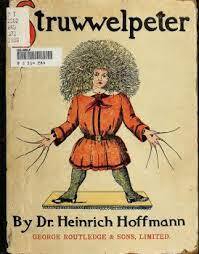German Fairytales
German fairy tales have a rich and enduring tradition deeply embedded in the country's cultural history. Renowned for their imaginative narratives and moral teachings, these tales often feature enchanting characters, mystical creatures, and magical realms. The Brothers Grimm, known for their collection of stories including "Cinderella," "Snow White," and "Hansel and Gretel," are among the most celebrated contributors to the genre. These tales often explore themes of courage, resilience, and the triumph of good over evil, resonating with audiences of all ages across the globe. German fairy tales continue to captivate and inspire readers, showcasing the timeless power of storytelling in preserving cultural heritage and imparting valuable life lessons.
Classic German Fairytales
- 1. StruwwelPeter
-
 "Struwwelpeter," written by Heinrich Hoffmann in 1845, is a famous German children's book comprising several
cautionary tales. The book is known for its darkly humorous and often gruesome stories, intended to teach
children moral lessons. The tales include "The Story of Little Suck-a-Thumb," where a boy who sucks his thumbs
is warned by a tailor with giant scissors, and "The Dreadful Story of Pauline and the Matches," where a girl
playing with matches meets a tragic end. Another tale, "The Story of Augustus Who Would Not Have Any Soup,"
narrates the consequences of a stubborn boy's refusal to eat his soup.
The book emphasizes the importance of obedience, good behavior, and the potential consequences of disobedience.
Despite its unsettling and often violent content, "Struwwelpeter" remains a notable piece of children's
literature that has had a lasting impact on popular culture.
"Struwwelpeter," written by Heinrich Hoffmann in 1845, is a famous German children's book comprising several
cautionary tales. The book is known for its darkly humorous and often gruesome stories, intended to teach
children moral lessons. The tales include "The Story of Little Suck-a-Thumb," where a boy who sucks his thumbs
is warned by a tailor with giant scissors, and "The Dreadful Story of Pauline and the Matches," where a girl
playing with matches meets a tragic end. Another tale, "The Story of Augustus Who Would Not Have Any Soup,"
narrates the consequences of a stubborn boy's refusal to eat his soup.
The book emphasizes the importance of obedience, good behavior, and the potential consequences of disobedience.
Despite its unsettling and often violent content, "Struwwelpeter" remains a notable piece of children's
literature that has had a lasting impact on popular culture.
- 2. Die Bremer Stadtmusikanten
-
Translated The Bremen Town Musicians "The Bremen Town Musicians" is a classic German fairy tale collected by the Brothers Grimm. It tells the story of four aging domestic animals—a donkey, a dog, a cat, and a rooster— who, after facing mistreatment and abandonment by their owners, set out on a journey to Bremen to become musicians. Along the way, they stumble upon a gang of robbers in a cottage and, with their wits and collective effort, manage to scare them off. They find the cottage to be a perfect shelter and decide to stay there, never actually making it to Bremen. The story emphasizes the importance of companionship, resourcefulness, and the value of friendship in overcoming adversity. It's a timeless tale that highlights the significance of mutual support and the idea that strength lies in unity, even when faced with seemingly insurmountable challenges.
- 3. Rumpelstilzchen
-
"Rumpelstiltskin" is a well-known German fairy tale collected by the Brothers Grimm, first published in 1812. The story revolves around a miller's daughter who is tasked with the seemingly impossible challenge of spinning straw into gold by the king. In desperation, she makes a deal with a magical little man named Rumpelstiltskin, who helps her complete the task in exchange for her firstborn child. When the time comes for her to fulfill her promise, Rumpelstiltskin offers her a chance to keep her child if she can guess his name. Through some clever detective work, the queen discovers his name and thwarts his plans. Rumpelstiltskin is so enraged that he tears himself in two. The tale serves as a cautionary reminder about the dangers of making deals with mysterious entities and the consequences of dishonesty. Despite its familiarity, "Rumpelstiltskin" continues to captivate audiences with its elements of magic, suspense, and the triumph of wit over deceit.